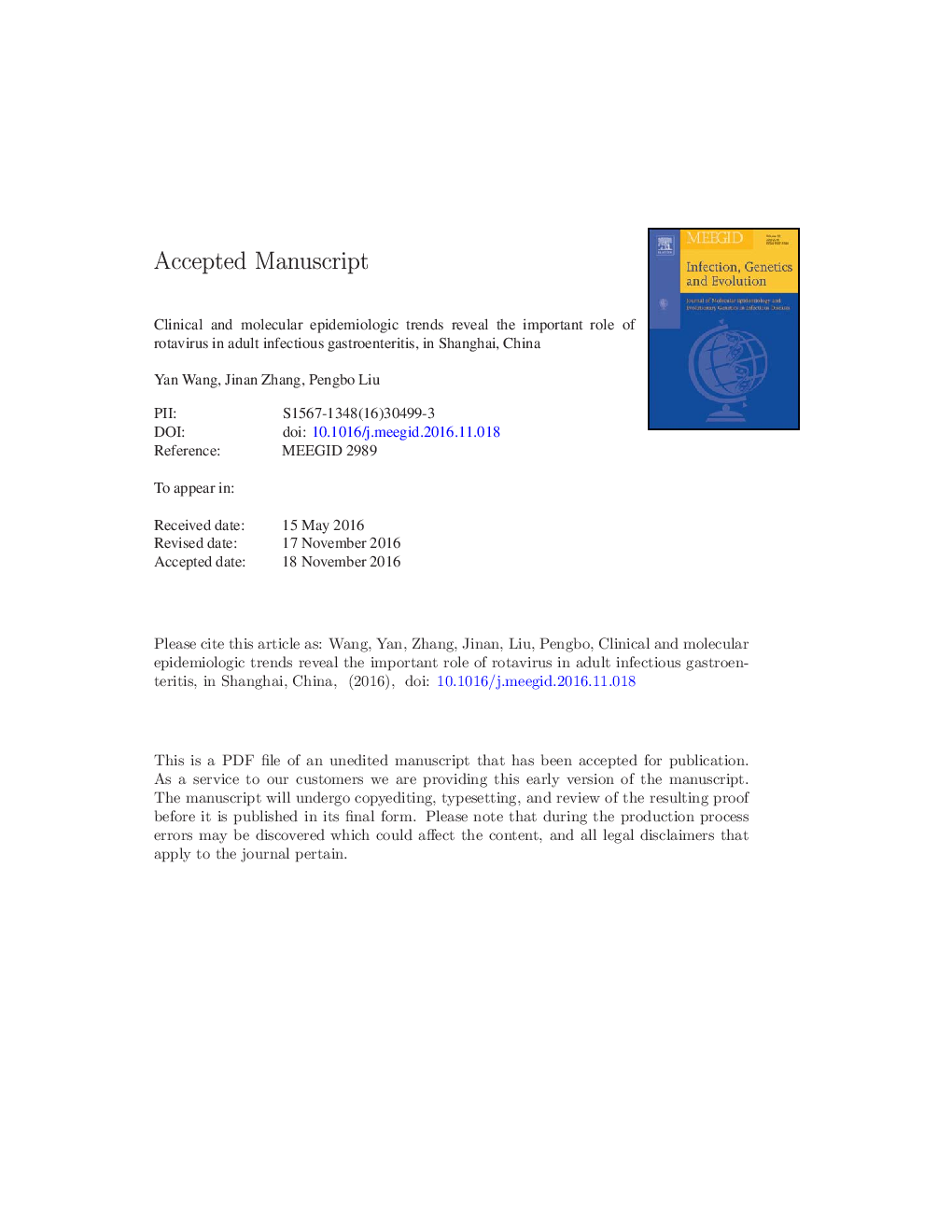| کد مقاله | کد نشریه | سال انتشار | مقاله انگلیسی | نسخه تمام متن |
|---|---|---|---|---|
| 5590477 | 1570156 | 2017 | 33 صفحه PDF | دانلود رایگان |
عنوان انگلیسی مقاله ISI
Clinical and molecular epidemiologic trends reveal the important role of rotavirus in adult infectious gastroenteritis, in Shanghai, China
ترجمه فارسی عنوان
گام های اپیدمیولوژیک بالینی و مولکولی نقش مهم روتاویروس در گاستروانتریت عفونی بزرگسالان را در شانگهای، چین
دانلود مقاله + سفارش ترجمه
دانلود مقاله ISI انگلیسی
رایگان برای ایرانیان
کلمات کلیدی
RT-PCRRVAamino acid - آمینو اسیدMolecular epidemiology - اپیدمیولوژی مولکولیadult - بالغphylogenetic analysis - تجزیه و تحلیل فیلوژنتیکGenogroup - جنوگروپRotavirus - روتاویروس Shanghai - شانگهایNucleotide - نوکلئوتیدreverse transcription-polymerase chain reaction - واکنش زنجیره ای رونویسی-پلیمراز معکوسgastroenteritis - گاستروانتریتgroup A rotavirus - گروه روتاویروس
موضوعات مرتبط
علوم زیستی و بیوفناوری
علوم کشاورزی و بیولوژیک
بوم شناسی، تکامل، رفتار و سامانه شناسی
چکیده انگلیسی
As a leading cause of severe diarrhea in children, the pathogenic role of rotavirus in adults has been underestimated for a long time. A hospital-based prospective clinical and molecular epidemiologic study of rotavirus infections in adults was performed between April 2014 and March 2015 in Shanghai, China. Overall, rotavirus was detected in 48 of 441 (10.9%) specimens with prevalence peaking in December (33.3%) and January (27.9%), whereas bacteria were identified in 45 of 846 (5.3%) samples (p < 0.01). The rotavirus winter-spring seasonality (November - March) contrasts with the marked summer-fall seasonality (April - October) of bacterial pathogens (p < 0.01). Compared with bacterial pathogens, rotavirus infection from child-to-adult transmission (29.8%, p < 0.01) was the most important epidemiologic setting generating a major impact on public health, i.e. increased adult burden of infectious gastroenteritis and genetic diversity of circulating rotaviruses; adults infected with rotavirus developed more severe gastroenteritis symptoms (p < 0.01) accompanied with mild intestinal and blood inflammations. Thirty-three G9 (lineages VIe and IIId), seven G2 (lineages IVa-1, IVa-3, and V) and two G1 (lineage Va) strains, together with thirty-eight P[8]-III and eight P[4]-V strains, were identified in this study with multiple amino acid differences observed between sample strains and homotypic vaccines. G9P[8] was the predominant genotype (66.7%), followed by G2P[4] (14.6%) and G1P[8] (4.2%). Eight conserved amino acid substitutions in prototype strain K-1, especially A212T in antigenic region C, formed a novel G9-lineage VIe variant that has emerged worldwide since 2010. Our results indicated that emerging rotavirus G9-VIeP[8]-III predominated over all the genotypes with a short time window in adults in Shanghai, China, and caused a local epidemic during the 2014-2015 rotavirus season. These findings reinforce the importance for inclusion of rotavirus in routine clinical diagnosis, and further surveillance of rotavirus variants is recommended to improve current vaccination program.
ناشر
Database: Elsevier - ScienceDirect (ساینس دایرکت)
Journal: Infection, Genetics and Evolution - Volume 47, January 2017, Pages 143-154
Journal: Infection, Genetics and Evolution - Volume 47, January 2017, Pages 143-154
نویسندگان
Yan Wang, Jinan Zhang, Pengbo Liu,
